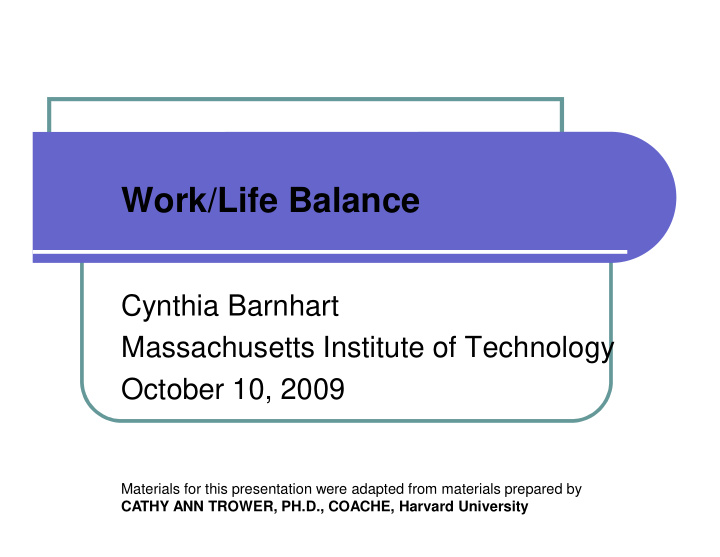



Work/Life Balance Cynthia Barnhart Massachusetts Institute of Technology October 10, 2009 Materials for this presentation were adapted from materials prepared by CATHY ANN TROWER, PH.D., COACHE, Harvard University
“Balance” is the Wrong Concept- Integration is key “Work-life balance is an unfortunate phrase because it denotes a sense of opposing forces—work versus life—and a steady state between them. We argue that work and life are intertwined and, therefore, must always be considered in tandem” (p. 60) Benko, C. & Weisberg, A. (2007). mass career customization: aligning the workplace with today’s nontraditional workforce. Boston: Harvard Business School Press.
Work-Life Integration � Is universally sought � 86% of U.S. workers said that ensuring work fulfillment and balance is a top career priority � 81% of U.S. workers work for employers that do not have programs that help them balance work and life
Generational Thinking Matters � Traditionalists (1925-1945) “Keepers of the Grail” � Boomers (1946-1960) “Thank God its Monday” � Gen X (1961-1980) “Work to Live” � Will (often) choose quality of life over pay and start- up package � Balance/integration extremely important � Flexibility is required � Feedback is desired � Protection from “too much” teaching and service desired � Millenials (1981-2000) “It’s all About Me”
Some of the things that should be done � Active Service Modified Duties (ASMD) Offer flexible part-time option for tenure-track faculty � Tenure-Clock Extension (Stop-the-clock) � ASMD and tenure clock extensions are automatic entitlements (opt-out policy) � � Parents Paid Childbearing Leave, unpaid Parental Leave (up to one year) � High quality university-sponsored infant and childcare � University-sponsored emergency back-up childcare system � Portion of childcare expenses covered for travel related to research grants � � Dual Career Hiring Practices � Mentoring: Formal and informal A mentoring mosaic –peers, near-peers (recently tenured), and senior � colleagues � Family friendly scheduling of meetings � Campus work-life advisory committees
Integrating Work and “Life” � Key ingredients: � Focus � Willingness to work � Willingness to not work � Priority setting � Organization/ time management � Management of expectations (especially your own) � The mix of ingredients- different for everyone! � Continuous monitoring and adjustment required � Beware the slippery slope � Distinct strategies for family-work interface and personal time-work interface
Some obserations and strategies that have worked for me… � Spending enough time on “work” is not a problem � Spending enough time on “life” can require discipline � Define obligations in a synergistic manner, to the extent possible � In research, in research and teaching, in service, in academic and professional service… � “Deadlines” � Time by which you leave the office � “Schedule and Commit” to “leisure time” � Exploit flexibility of your job � In schedule � In what you do � Prioritize responsibilities � Make lists � Don’t do some things � Let someone else do them if it isn’t a priority for you
Recommend
More recommend